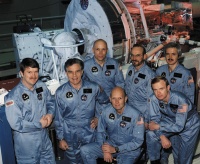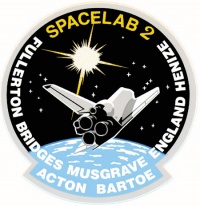STS-51F
From The Space Library
 | |
| Organization | NASA-OfficeofSpaceScienceApplications(UnitedStates),NASA-Office of Space Flight (United States) |
|---|---|
| Mission type | Astronomy,Human Crew,Life Science,Microgravity,Planetary Science,Solar Physics,Space Physics |
| Launch date | July 29, 1985 |
| Launch vehicle | Space Shuttle |
| Launch site | Cape Canaveral, United States |
| COSPAR ID | 1985-063A |
| Inclination | 49.5 degrees |
| Experiments | Here |
| Alternate Names | STS 19,Spacelab 2,15925 |
| Additional Information | Here |
| Data Collection | Here |
| Payload Mass Up | 15603 kg |
| Payload Mass Down | kg |
| Orbiter | Challenger |
| Lift Off Mass | 2,052,524.55 kg |
| Orbiter Weight at Liftoff | 114,830.91 kg |
| Orbiter Weight at Landing | 98,515.91 kg |
| Landed | Runway 23 dry lake bed at Edwards Air Force Base, Calif. |
| Orbits of Earth | 126 |
| Orbital Altitude | 143 nautical miles (164 statute miles) |
Contents |
[edit] Crew
- Commander: Gordon Fullerton
- Pilot: Roy Bridges
- Payload Commander:
- Mission Specialist 1: Story Musgrave
- Mission Specialist 2: Anthony England
- Mission Specialist 3: Karl Henize
- Mission Specialist 4:
- Mission Specialist 5:
- Payload Specialist 1: Loren Acton
- Payload Specialist 2: John-David Bartoe
ISS/Mir Crew Transport
[edit] Mission
Spacelab 2, a NASA developed payload, had a configuration that included an igloo attached to a lead pallet, with the Instrument Pointing Subsystem (IPS) mounted on it, a two pallet train, and an experiment special support structure. The flight objective was to demonstrate Spacelab's capabilities through a multidisciplinary research program and to verify system performance. Investigations in the field of astrophysics and solar astronomy included a sky survey for extended infrared sources, x-ray imaging of cluster galaxies, cosmic ray measurements, studies of small-scale structures on the sun's surface, and a measurement of the coronal helium abundance. In addition, there were measurements of: the solar ultraviolet flux; the plasma environment and plasma processes near the Orbiter; and zero-gravity effects on technology processes and on the behavior of liquid helium. Life sciences problems investigated included bone demineralization in humans and lignin formation in plants.
[edit] EVA
[edit] Payload
Spacelab-2 with 13 experiments; Shuttle Amateur Radio Experiment (SAREX); Protein Crystal Growth (PCG).
[edit] Books about the Space Shuttle Program
Buy This Book Click here |
Buy This Book here |
Buy This Book Click here |
Buy This Book Click here |





